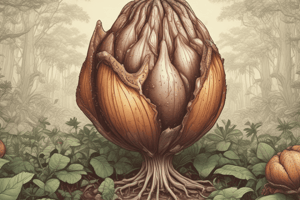Podcast
Questions and Answers
What is the primary storage polysaccharide in fungi?
What is the primary storage polysaccharide in fungi?
- Starch
- Cellulose
- Glycogen (correct)
- Chitin
What is the function of haustoria in parasitic fungi?
What is the function of haustoria in parasitic fungi?
- To form symbiotic relationships with algae
- To produce spores
- To synthesize amino acids
- To absorb nutrients from the host (correct)
What type of association do mycorrhizal fungi form with plants?
What type of association do mycorrhizal fungi form with plants?
- Mutualistic (correct)
- Parasitic
- Commensal
- Symbiotic
How do fungi typically obtain energy?
How do fungi typically obtain energy?
What is a characteristic feature of fungal infections in plants?
What is a characteristic feature of fungal infections in plants?
What is the term for the thread-like structures of fungi?
What is the term for the thread-like structures of fungi?
Which of the following is NOT a common symptom of fungal infections in plants?
Which of the following is NOT a common symptom of fungal infections in plants?
What is the term for the reproductive structures of fungi?
What is the term for the reproductive structures of fungi?
How do fungi obtain their amino acids and proteins?
How do fungi obtain their amino acids and proteins?
What is the term for fungi that form symbiotic associations with algae?
What is the term for fungi that form symbiotic associations with algae?
Flashcards are hidden until you start studying
Study Notes
Fungal Plant Diseases
- Fungi are eukaryotic, spore-forming, non-chlorophytic organisms, with over 100,000 species, and most are saprophytes.
- Around 20,000 species of fungi are parasites and cause disease in crops and plants.
- Fungal parasites are the most prevalent plant pathogenic organisms, and individual species can parasitize one or many different kinds of plants.
Biology of Fungi
- Fungi are small, eukaryotic, usually filamentous, branched, spore-bearing organisms that lack chlorophyll.
- Fungi can be obligate parasites (biotrophs) or non-obligate parasites (facultative saprophytes or facultative parasites).
- Fungi have a filamentous vegetative body called a mycelium, which branches out in all directions, with individual branches called hyphae.
- Fungi reproduce by means of spores, which are reproductive bodies consisting of one or a few cells.
Morphological Characteristics
- Fungi have a diverse range of morphological structures, including special root-like structures (rhizoid) for absorbing food.
- Parasitic fungi produce special hyphal branches (haustoria) that penetrate host cells and obtain food from the protoplasm.
- Some fungi form symbiotic associations with the roots of higher plants (mycorrhizal fungi) or associate with algae (lichens).
- Fungi use carbohydrates and nitrogen compounds to synthesize their own amino acids and proteins.
Diagnostic Signs and Symptoms of Fungal Infections
- Fungi can cause general or localized signs and symptoms, including general necrosis of host tissue, stunting, distortions, and abnormal changes in plant tissue and organs.
- The physical presence of signs of the pathogen (hyphae, mycelia, fruiting bodies, and spores) are significant clues to proper identification and diagnosis of a disease.
- Fruiting bodies of fungi range from microscopic to macroscopic and come in many shapes and configurations.
Management of Fungal Plant Diseases
- Genetic Host Resistance: Using genetically resistant species, cultivars, varieties, and hybrids.
- Cultural Practices:
- Planting only disease-free certified seed.
- Maintaining a balanced fertility program.
- Implementing effective water management.
- Removing crop residues by burning or burying (plowing).
- Implementing crop rotation strategies to reduce or eliminate the interaction of susceptible plants with pathogens.
- Growing crops in climates unsuitable for pathogenic fungi.
Examples of Fungal Diseases
- Club root of crucifers - caused by Plasmodiophora brassicae
- Late blight of potatoes - caused by Phytophora infestans
- Pythium seed rot, damping-off, root-rot, and soft rot
- Powdery mildews of various crops - caused by many species of fungi of the family Erysiphaceae
- Alternaria leafspots - caused by a variety of Alternaria spp.
Studying That Suits You
Use AI to generate personalized quizzes and flashcards to suit your learning preferences.




